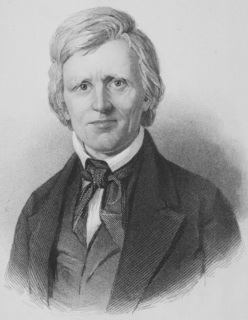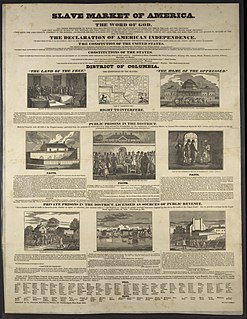
Abolitionism, or the abolitionist movement, was the movement to end slavery. In Western Europe and the Americas, abolitionism was a historic movement that sought to end the Atlantic slave trade and liberate the enslaved people.

Gamaliel Bailey was an American physician who left that career to become an abolitionist journalist, editor, and publisher, working primarily in Cincinnati, and Washington, D.C. Anti-abolitionist mobs attacked his offices in both cities during the 1840s.

William Lloyd Garrison was a prominent American Christian, abolitionist, journalist, suffragist, and social reformer. He is best known for his widely-read anti-slavery newspaper The Liberator, which he founded in 1831 and published in Boston until slavery in the United States was abolished by Constitutional amendment in 1865. Garrison promoted "no-governmentism" and rejected the inherent validity of the American government on the basis that its engagement in war, imperialism, and slavery made the government corrupt and tyrannical. He initially opposed violence as a principle and advocated for Christian nonresistance against evil; at the outbreak of the civil war, he abandoned his previous principles and embraced the armed struggle and the Lincoln administration. He was one of the founders of the American Anti-Slavery Society, and promoted immediate and uncompensated, as opposed to gradual and compensated, emancipation of slaves in the United States.
The source of Garrison's power was the Bible. From his earliest days, he read the Bible constantly and prayed constantly. It was with this fire that he started his conflagration. ... So also, a prejudice against all fixed forms of worship, against the authority of human government, against every binding of the spirit into conformity with human law, — all these things grew up in Garrison's mind out of his Bible reading.

John Greenleaf Whittier was an American Quaker poet and advocate of the abolition of slavery in the United States. Frequently listed as one of the fireside poets, he was influenced by the Scottish poet Robert Burns. Whittier is remembered particularly for his anti-slavery writings, as well as his 1866 book Snow-Bound.

Historians who debate the origins of the American Civil War focus on the reasons that seven Southern states declared their secession from the United States and united to form the Confederate States, and the reasons that the North refused to let them go. Proponents of the pseudo-historical Lost Cause ideology have denied that slavery was the principal cause of the secession. While historians in the 21st century agree on the centrality of the conflict over slavery—it was not just "a cause" of the war but "the cause"—they disagree sharply on which aspects of this conflict were most important.

The Lincoln–Douglas debates were a series of seven debates between Abraham Lincoln, the Republican Party candidate for the United States Senate from Illinois, and incumbent Senator Stephen Douglas, the Democratic Party candidate. Until the Seventeenth Amendment to the United States Constitution, which provides that senators shall be elected by the people of their states, was ratified in 1913, senators were elected by their respective state legislatures, so Lincoln and Douglas were trying to win control of the Illinois General Assembly for their respective parties.

In the United States before 1865, a slave state was a state in which slavery and the slave trade were legal, while a free state was one in which they were not. Between 1812 and 1850, it was considered by the slave states to be politically imperative that the number of free states not exceed the number of slave states, so new states were admitted in slave–free pairs. There were, nonetheless, some slaves in most free states up to the 1840 census, and the Fugitive Slave Act of 1850 specifically stated that a slave did not become free by entering a free state.

The Liberator (1831–1865) was a weekly abolitionist newspaper, printed and published in Boston by William Lloyd Garrison and, through 1839, by Isaac Knapp. Religious rather than political, it appealed to the moral conscience of its readers, urging them to demand immediate freeing of the slaves ("immediatism"). It also promoted women's rights, an issue that split the American abolitionist movement. Despite its modest circulation of 3,000, it had prominent and influential readers, including Frederick Douglass and Beriah Green. It frequently printed or reprinted letters, reports, sermons, and news stories relating to American slavery, becoming a sort of community bulletin board for the new abolitionist movement that Garrison helped foster.
In American history, the Fire-Eaters were a group of pro-slavery Democrats in the Antebellum South who urged the separation of Southern states into a new nation, which became the Confederate States of America. The dean of the group was Robert Rhett of South Carolina. Some sought to revive America's participation in the Atlantic slave trade, which had been illegal since 1808.

In the British colonies in North America and in the United States before the abolition of slavery in 1865, free Negro or free Black described the legal status of African Americans who were not enslaved. The term was applied both to formerly enslaved people (freedmen) and to those who had been born free.

The Society for the Mitigation and Gradual Abolition of Slavery Throughout the British Dominions, founded in 1823 and known as the London Anti-slavery Society during 1838 before ceasing to exist in that year, was commonly referred to as the Anti-Slavery Society.

The Wayside is a historic house in Concord, Massachusetts. The earliest part of the home may date to 1717. Later it successively became the home of the young Louisa May Alcott and her family, who named it Hillside, author Nathaniel Hawthorne and his family, and children's writer Margaret Sidney. It became the first site with literary associations acquired by the National Park Service and is now open to the public as part of Minute Man National Historical Park.

The North Star was a nineteenth-century anti-slavery newspaper published from the Talman Building in Rochester, New York, by abolitionist Frederick Douglass. The paper commenced publication on December 3, 1847, and ceased as The North Star in June 1851, when it merged with Gerrit Smith's Liberty Party Paper to form Frederick Douglass' Paper. At the time of the Civil War, it was Douglass' Monthly.

Nathaniel Peabody Rogers was an American attorney turned abolitionist writer, who served, from June 1838 until June 1846, as editor of the New England anti-slavery newspaper Herald of Freedom.
The Liberty Party was a minor political party in the United States in the 1840s. The party was an early advocate of the abolitionist cause and it broke away from the American Anti-Slavery Society (AASS) to advocate the view that the Constitution was an anti-slavery document. William Lloyd Garrison, leader of the AASS, held the contrary view, that the Constitution should be condemned as an evil pro-slavery document. The party included abolitionists who were willing to work within electoral politics to try to influence people to support their goals. By contrast, the radical Garrison opposed voting and working within the system. Many Liberty Party members joined the anti-slavery Free Soil Party in 1848 and eventually helped establish the Republican Party in the 1850s.

The Massachusetts General Colored Association was organized in Boston in 1826 to combat slavery and racism. The Association was an early supporter of William Lloyd Garrison. Its influence spread locally and was realized within New England when they joined the New England Anti-Slavery Society in 1833.

In the United States, abolitionism, the movement that sought to end slavery in the country, was active from the late colonial era until the American Civil War, the end of which brought about the abolition of American slavery through the Thirteenth Amendment to the United States Constitution.

Colonel Jonathan Peckham Miller (1797–1847) was an American abolitionist. He served in Greece and returned to be a politician standing up for the rights of slaves and women. He and Sarah Arms Miller used their house as a station on the Underground Railroad.

The slave trade in the District of Columbia was legal from its creation until 1850, when the trade in enslaved people in the District was outlawed as part of the Compromise of 1850. That restrictions on slavery in the District were probably coming was a major factor in the retrocession of the Virginia part of the District back to Virginia in 1847. Thus the large slave-trading businesses in Alexandria, such as Franklin & Armfield, could continue their operations in Virginia, where slavery was more secure.
Margaret Lucy Shands Bailey was an American anti-slavery writer, poet, lyricist, as well as newspaper editor and publisher. She served as editor of The Youth's Monthly Visitor, a children's magazine, and as the publisher of The National Era, an anti-slavery journal.


















